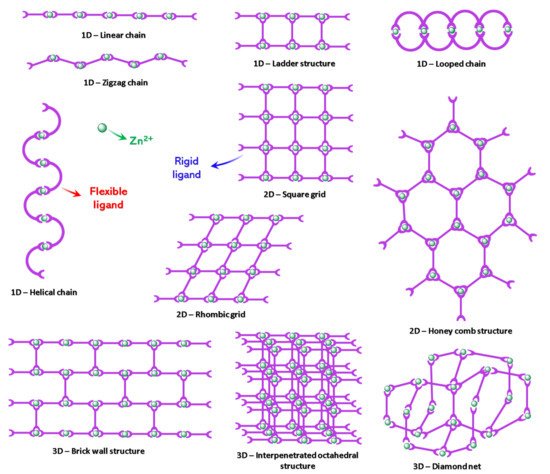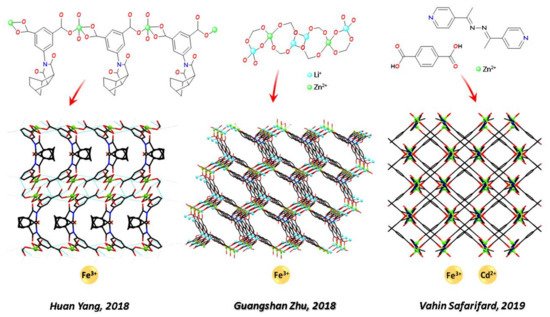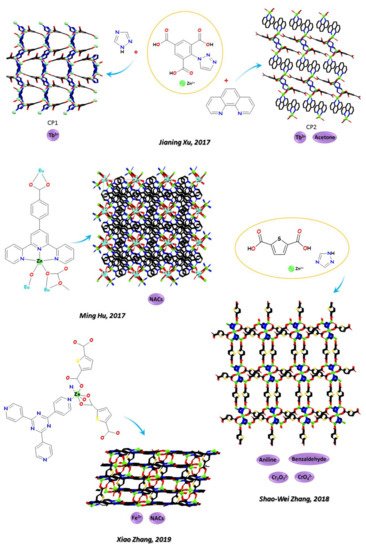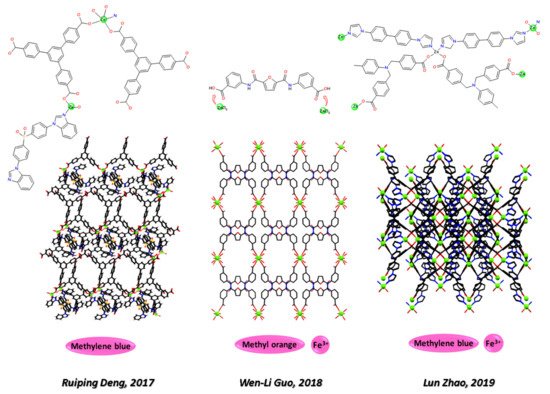2.1. Mono or Multifunctional Metal Cations Sensing
Recent relevant examples of Zn-CPs metal sensing were presented in 2017–2019. In 2017 Jian-Ping Lang and coworkers
[107] presented a deeply characterised series of a 1D and four 3D Zn-CPs obtained by ligands 1,4- bis(2-(pyridin-4-yl)vinyl)naphthalene and 1,3,5-benzene-tricarboxylic acid in different molar ratio. The structural pattern of the five CPs was explored, and their luminescent response toward Hg
2+ was examined. Specifically, the more representative example resulted highly selective and sensitive for the detection of Hg
2+ ion. A finely ground sample suspended in N, N dimethylformamide (DMF) solvent undergoes a fluorescence quenching and a change of fluorescence colour from blue to yellow naked eye perceivable under UV light. As an essential trace element in the human body, crucial in several biological processes, iron ion is a desirable metal target. In 2020, Zhong-Feng Shi and coworkers
[116] published another prominent article on two Zn-CPs produced by hydrothermal reactions of ligands 5-sulfosalicylic acid and 1,4-bis(1H-imidazol-1-yl) benzene (1,4-bib) for different reaction time. After two days reacting, a 2D structure was obtained, while a 3D coordination polymer was obtained after the same mixture reacted for three days, each structural unit being linked by ten 1,4-bib ligands to form a 3D MOF. The 2D CP shows excellent fluorescence quenching response toward Fe
3+ and the 3D CP toward Hg
2+. The quenching mechanism was explored in both cases and ascribed to the absorption of the emitted light for Fe
3+ and to the electron transfer and weak interaction of Hg
2+. In 2018, two Fe (III) quenching responsive and highly selective Zn-MOFs were described. Specifically, Huan Yang and coworkers
[117] (see
Figure 1) produced a luminescent Tb
3+ and Eu
3+ encapsulated Zn-MOF based on 5-(5-norbonene-2,3-dicarboximide)isophthalic acid, and Guangshan Zhu and coworkers (see
Figure 1)
[118] obtained a mixed Li
+ and Zn
2+ based MOF from the quadridentate carboxylate ligand 5-(bis(4-carboxybenzyl)amino)isophthalic acid.
Figure 1. Some representative structures of Zn-CPs for metal cation sensing. Figures readapted by using Mercury software
[119].
The simultaneous detection of selectively trapped metal cation is a desirable property of some LMOFs. Many Zn-MOFs for simultaneous detection of iron and another metal cations are known, such as the Eu
3+ encapsulated Zn-LMOF based on tetrakis(4-pyridyloxymethylene)methane and 2,6-naphthalenedicarboxylic acid able to detect Fe
3+ and Cr
4+ ions (Xin Liu and coworkers
[120], 2017); the Zn-MOF responsive to Fe
3+ and Al
3+ ions (Xia Li and coworkers
[121], 2018) assembled from 3,3′-diphenyldicarboxylate and 1,4-bis(1,2,4-triazol-1-yl)butane; the Zn-MOF named TMU-16 from a bipyridyl ligand with a bridging azine group (Vahid Safarifard and coworkers, 2019, see
Figure 1,
[122],) displaying a luminescence quenching response to Fe
3+ and a luminescence enhancement response to Cd
2+ ions.
2.2. Multi-Sensing of Metal Cations, Oxyanions, and Nitro Aromatic Compounds
Among the innumerable LCPs, several Zn-LCPs have drawn attention as highly selective multi-analytes probes. Simultaneous operativity is a sought-after property, and it enables the probe to be employed in an actual technological use. Multi-responsive Zn-CPs explored in the last years can detect simultaneously metal cations (mainly Fe
3+), anions, and small molecules. Specifically, common carcinogenic pollutants of aqueous solutions used in several industrial applications
[123][124][125] such as NACs (nitro aromatic compounds) and chromium (VI) oxoanions (Cr
2O
72−, CrO
42−) are the target analytes of 3D Zn-CPs.
Recent examples are the work of Bao-Long Li and coworkers, which in 2018
[126] studied the crystalline pattern of five Zn-CPs based on the ligand 1,3-bis(1,2,4-triazol-4-ylmethyl)benzene with different co-ligands (btec = 1,2,4,5-benzenetetracarboxylate, Meip = 5-methylisophthalate, nip = 5- nitroisophthalate, hip = 5-hydroxyisophthalate, nbdc = 4-nitro-1,2-benzenedicarboxylate). The CPs display different structural patterns and dimensionality from 1D to 3D. The 3D CP shows a (4,4)-connected self-catenated 3D network of the 4,4T32 topological type and is a highly sensitive and selective luminescence sensor for Fe
3+, Cr
2O
72−, and CrO
42− in aqueous solution, with detection limits of 6.28, 3.05, and 5.72 μM, respectively, and an assumed quenching mechanism. In the same year, Lin Dua, Qi-Hua Zhao, and coworkers (see
Figure 2)
[127] synthetised three novel LCPs from the flexible zwitterionic ligands 1,1′,1″-(2,4,6-trimethylbenzene-1,3,5-triyl)-tris(methylene)tris-(4-carboxypyridinium)tribromide and 1,2,4,5-tetrakis-(4-carboxylatopyridinium-1-methylene)benzene and zinc (II) or cadmium (II) d
10 cations. They compared the different structural pattern and dimensionality promoted by the metal and the related sensing ability toward Fe
3+, nitrobenzene (NB), and HSO
4− anions.
Figure 2. Some representative structures of Zn-CPs for multi-sensing of metal cations, oxyanions, and NACs metal cation sensing. Figures readapted by using Mercury software
[119].
In 2019, Hao Lei and coworkers
[128] obtained a series of 2D Zn-CPs by ionothermal reaction a series of 2D Zn-CPs named {Zn2 × 2(BDC)(L)}n where X = Cl (1 and 3) or Br (2 and 4), BDC = 1,4-benzenedicarboxylate, L = 4,4′-bipyridine (4,4′-bpy, 1 and 2) or 1,4-diazabicyclo [2.2.2]octane (dabco, 3 and 4). The polymer 1 (with chloride and 4,4′-bpy) displays strong luminescence in the solid state and selective luminescence quenching for Fe
3+ ions and nitroaromatic compounds (NACs) in ethanol solutions, while the polymer 4 (with bromide and dabco) can selectively adsorb Congo red dye from other dye molecules. In 2020, Yujuan Zhang and coworkers
[129] used copper (II) in a case and zinc (II) in another case as metal nodes to produce two CPs, namely [(Cu(bib)2)⋅2NO
3⋅H
2O]n and [[Zn
3(bib)2.5(C
2O
4)3(H
2O)]] DMF⋅H2O]n. By structural analysis, the polymeric arrangements were compared and both CPs were found to be 2D frameworks further expanded into 3D supramolecular structures through C–H⋯O hydrogen bonding. The sensing pathway was examined. The CPs were found to be quenching responsive to Fe
3+ and NACs, through a PET (photoinduced electron transfer) and RET (resonance energy transfer) mechanism for NACs, and a RET mechanism for Fe
3+, respectively. Very recently, Baokuan Chen and coworkers
[130] explored the influence of carboxylic acid substituents on the structural and emissive pattern of three Zn-CPs built from isophthalic acid (1), 5-hydroxyisophthalic acid (2), and 5-nitroisophthalic acid (3), respectively, and the N-donor ligand N,N’-bis(4-methylenepyridin-4-yl)-1,4-naphthalene dicarboxamide. The CPs have similar 4,4-connected 2D structures exhibiting different structural details and show multi-functional fluorescence response towards metal ion (Fe
3+), anions (MnO
4−, Cr
2O
72−, CrO
42−), and 2,6-dichloro-4-nitroaniline. The luminescence quenching effect was not ascribed to any skeleton collapse but to an energy competitive absorption mechanism, which leads to a RET effect.
Zn-CPs can be useful tools also for detection of rare heart metals. Jianing Xu and coworkers (see
Figure 3)
[131] in 2017 obtained two Zn-LCPs based on ligand 1- (triazol-1-yl)-2,4,6-benzene tricarboxylic acid and 1,2,4-triazole (1) and 1,10-phenanthroline (2), respectively. CP1 shows a 3D framework helical chain and CP2 shows a 2D layered network extending to 3D structure through π–π stacking interactions. Both CPs perform as hosts for the encapsulation of Ln
3+ ions and serve as antennae to sensitize Tb
3+ ions. In addition, CP2 exhibits highly luminescent sensing properties for acetone.
Figure 3. Other representative structures of Zn-CPs for multi-sensing of metal cations, oxyanions, and NACs metal cation sensing. Figures readapted by using Mercury software
[119].
Recently, examples of 3D tools as Zn-LMOFs selectively detecting nitro derivatives were studied in depth both from the structural and functional point of view. In 2020, Ji-Young Zou, Sheng-Young You
[132], and coworkers (see
Figure 2); in 2017, Ming Hu and coworkers (see
Figure 3)
[133]; and in 2019, Xiangyang Qin and coworkers
[134] ascertained the quenching mechanism imposed by the presence of NACs in a series of Zn-LMOFs where a ruling FRET process affected the luminescence response of the probe. In other cases, multifunctional Zn-LMOFs was able to selectively detect NACs and/or Cr
2O
72− and CrO
42− anions, and/or Fe
3+, and a series of selected examples are briefly reported below. As relevant examples, in the same year (2018), Suna Wang and coworkers
[135] produced two Zn-LMOFs based on 2,2′-[benzene-1,3-diylbis(methanediylsulfanediyl)]dibenzoic acid, 1,3-bis(4-pyridyl)propane, 1,2-Bis(4-pyridyl)ethylene, and DMF (N,N-Dimethylformamide), and He-Gen Zheng and coworkers
[136] produced three Zn-LMOFs, based on E,E-2,5-dihexyloxy-1,4-bis-(2-pyridin-vinyl)-benzene, 1,4-cyclohexanedicarboxylic acid, 4,4′-oxybisbenzoic acid, and 4,4′-sulfonyldibenzoic acid for selective detection of Fe
3+ and Cr
2O
72-. The same couple of analytes were selectively detected by the MOF named [Zn(dptz)(BDC)(H
2O)]n [1, dptz = 3,6-di(1H-pyrazol-4-yl)-1,2,4,5-tetrazine, H
2BDC = terephthalic acid] (Xian-He Bu and coworkers
[137], 2020) and by the MOFs named [Zn
2(HL) (phen)]n and [Zn
2(HL)(2,2-bipy)]n obtained from the V-pattern multi-carboxylic acid ligand H
5L = 3,5-di(2′,5′-dicarboxylphenyl)benzoic acid (Tuoping Hu and coworkers 2019
[138]).
NACs and Fe
3+ can be selectively detected by a Zn MOF with a 3-fold interpenetrating 3D framework based on tpt = 2,4,6-tri(pyridin-4-yl)-1,3,5-triazine and H
2tda = 2,5-thiophene dicarboxylic acid (Xiao Zhang and co-workers in 2019, see
Figure 3 [139]) and by the MOFs obtained by 4,40,400-nitrilotribenzoic acid (H
3NTB) and 1,10-phenanthroline (phen) (Lirong Yang and coworkers in 2021
[140]). In all cases, a quenching response was detected for both analytes. Multi-responsive probes for NACs, Fe
3+, and Cr (VI) oxo-anions were designed by Zhong-Feng Shi and coworkers in 2020
[141] based on 3-nitro-4,4′-biphenyl dicarboxylic acid and 11,4-bis(imidazole-1-ylmethyl)-benzene. Aniline, benzaldehyde in DMF and Cr
2O
72−/CrO
42− anions in water can be selectively detected by the Zn-MOF based on a pentametallic clusters and thiophene-2,5-dicarboxylic acid (Shao-Wei Zhang and coworkers (see
Figure 3)
[142], 2018).
2.3. Multi-Sensing of Biologically Harmful Small Organic Molecules
Many 3D Zn-CPs have been designed to be highly selective toward specific small molecules. Zn- MOFs responsive towards environmental organic pollutants, such as VOCs and water-soluble organic dyes and pesticides, are highly required in water quality tests. In many cases, they are selective multifunctional probes. Very recently, a variety of Zn-LMOFs probes selectively responsive towards biologically harmful molecules generated as wastewater from industrial processes
[143] have been produced.
Huai-Ming Hu in 2016
[144] prepared three Zn-CPs based on 40-(4-carboxyphenyl)-60-carboxycalte-2,20-bipyridine and glutaric acid. Depending on different pH values and auxiliary ligands, different 2D (hcb topological net and layer structure) or 3D (eight-membered rings self-penetrating MOF structure) CPs were obtained. The Zn-LMOF shows high-sensitivity sensing to metal cations (Fe
3+ and Cu
2+) and harmful small organic molecules (as methanol and nitrobenzene). More recently, in 2020, Jianrong Li
[145] and coworkers synthetised a 3D Zn-LCP by the reaction of Zn(NO
3)
2, N,N′- bis (3-pyridinecarboxamide)-1,4-butane and 4, 4′- oxidiphthalic acid. Besides the in-deep structural analysis, the polymer demonstrated remarkable fluorescent properties and chemical stability under an acidic or alkaline environment. It was used as a multifunctional chemosensor for detection of metal cations (Fe
3+, Bi
3+), oxyanions (MnO
4−, Cr
2O
72−), and toxic organic solvents such as NB, acetaldehyde, and acetylacetone. The mechanism of sensing process indicated that the synergistic effect of electron transfer by both luminescent ligands and the FRET mechanism leads to fluorescence quenching.
In some cases, Zn-LMOFs are designed to be highly selective toward highly specific small molecules. In 2018, Jian-Zhong Cui and coworkers
[146] produced an anionic Zn-MOF from furan-2,5-dicarboxylic acid and 1H-benzotriazole working as a turn-off luminescent sensor toward a volatile and flammable analytical reagent, acetylacetone. The selective structural cavities of MOFs make them ideal candidates for detecting VOCs upon adsorption. Patima Nizamidin and coworkers in 2019
[147] proposed a series of Zn MOFs, derived from terephthalic acid and N,N’-di(4-pyridyl)-1,4,5,8-naphthalenediimide. Formed in thin glassy films, the MOFs membranes display a selective adsorption response to meta-xylene gas. In 2019, Bing-Hui Wanga and Bing Yan
[148] designed a Zn-MOF based on a fluorescein dianion functionalized dye for the detection of the small trichloroacetic acid (TCA), a carcinogen metabolite in human urine.
Zn-MOFs responsive towards environmental organic pollutants, such as organic dyes and pesticides, are sensing tools in water quality tests. In 2017, Ruiping Deng and coworkers (see
Figure 4)
[149] reported a Zn-MOF built from bis(4-benzylimidazol-ylphenyl)sulfone and 4,4′,4′’-benzene-1,3,5-triyltribenzoic acid responsive to methylene blue. Wen-Li Guo and coworkers (see
Figure 4) in 2018
[150] and Lun Zhao and coworkers (see
Figure 4) in 2019
[151] studied two multifunctional systems for sensing of iron and a dye. Based on an 8-fold interpenetrating diamond network of N,N0-bis(4-carbozylbenzyl)-4-aminotoluene) ligand
[151] and on one of bis-(3-carboxy-phenyl)furan-2,5-dicarboxamide
[150], respectively, the first one selectively traps methylene blue and the second one methyl orange dye.
Figure 4. Some representative structures of Zn-CPs for multi-sensing of biologically harmful small organic molecules. Figures readapted by using Mercury software
[119].
In 2020, three relevant articles were produced on multifunctional MOFs probes for environmental pollutants. Jarugu Narasimha Moorthy and coworkers
[152] synthetised a Zn-MOF with ca. 27% solvent-accessible void volume based on a tetracarboxylic acid ligand with a twisted dibenzo[g,p]chrysene core (2,7,10,15-tetrakis [2,6-dimethyl-4-(α-carboxy)methoxyphenyl]-dibenzo[g,p]chrysene) highly specific in water toward hazardous “quat” dicationic herbicide with diquaternary bipyridyl motifs. Xiutang Zhang and coworkers
[153] used a 3D self-penetrated framework based on 1,3-bis (imidazol-1-ylmethyl)benzene and
π-conjugated aromatic
p-terphenyl-2,2″,5″,5‴-tetracarboxylate acid for DCN (2,6- dichloro-4-nitroaniline) pesticide and for nitrofuran NFT (nitrofurantoin) and NTZ (nitazoxanide) antibiotics. Finally, Qinhe Pan and coworkers
[154] designed a Zn MOF for the detection of U(VI) as a potential environmental pollutant.





